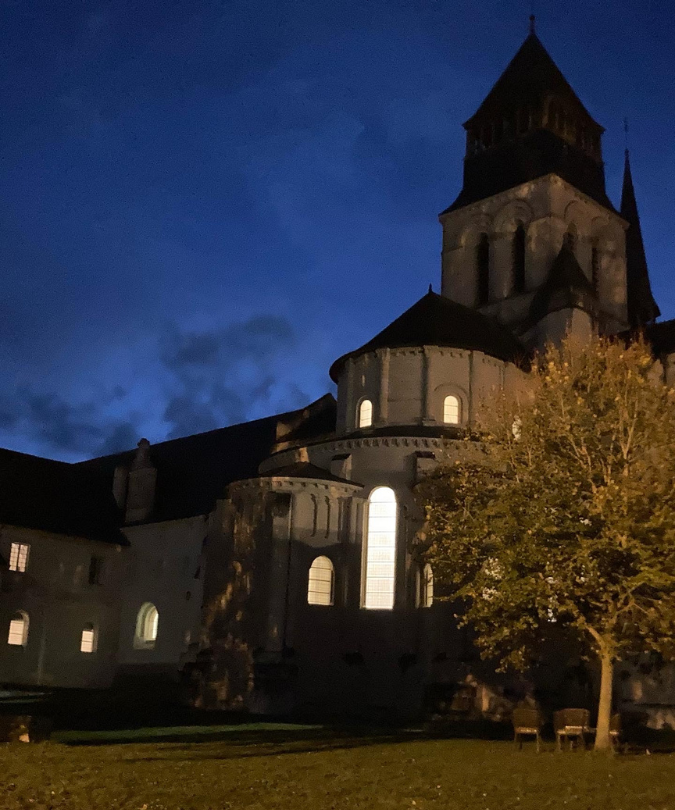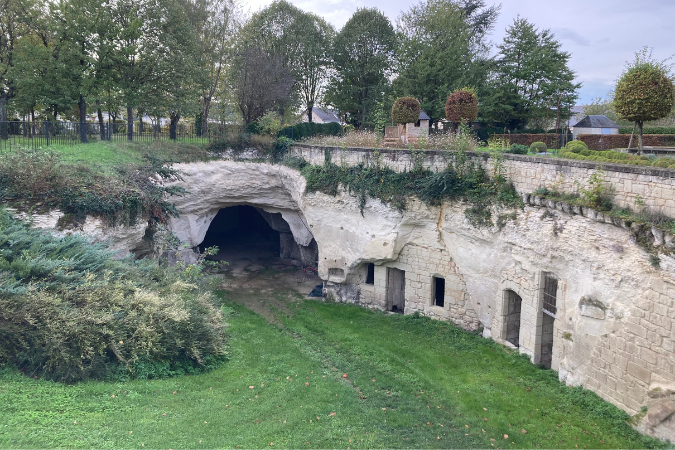For this woman, International Women’s Day has always provoked a few uncomfortable questions: are we being celebrated, marketed to or simply paroled – a day a year, for good behaviour? Ancient Rome had an annual Saturnalia festival during which all rules were reversed and slaves could command their masters. This, it seems to me, was a conservative move: there’s nothing like a temporary relaxation of the rules to remind you of their force.
My own International Women’s Moment came not in March but in November, in the eerie quiet of an ancient building at midnight. Atop four tombs, a quartet of figures gaze forever at the graceful vaulted ceiling of Fontevraud Abbey, between Chinon and Saumur in the heart of the Loire Valley.
Two are women, one of whom holds an open book, as if Heaven were a chance to finally get some reading done – a notion that greatly appeals to me. She is Eleanor of Aquitaine, whose stormy marriage to the figure beside her brought Bordeaux into the possession of England: an accident of history for which every modern wine lover is forever grateful. She spent the last years of her long life in this unconventional Abbey, founded in 1101 with an Abbess in charge of inhabitants who were both male and female – a shocking shattering of contemporary conventions.

Eleanor’s sojourn here a century later explains her posthumous presence, but given that her marriage to England’s Henry II went so wrong that she incited their sons to treason and he locked her up for 16 years, their juxtaposition is surprising. The presence of her son Richard the Lionheart, who made her regent while was on Crusade, is less so.
The fourth figure is not a king – and certainly not Richard’s brother King John, who lost most of England’s French territories during his reign. It is John’s wife, Isabel of Angoulême, who was nearly as interesting and strong-minded a medieval woman as her mother-in-law.
In my glass, I want what Eleanor probably wanted, nearly 1,000 years ago: something that makes me feel free
I was here, of course, not for history but for wine. I’d spent the morning tasting at Vigneau-Chevreau, 33 biodynamic hectares in Vouvray: lovely wines at prices only possible because most of the world hasn’t noticed what a marvellous variety Chenin Blanc is. Ivan Massonnat, of Domaine Belargus in Anjou – a wealthy banker now pursuing liquid gold – believes that Chenin will be climate change’s answer to Chardonnay: “This is the new Burgundy and in 100 years everyone will acknowledge that.”
I had wanted to visit Montlouis, where Jacky Blot of Domaine de la Taille aux Loups makes wondrously complex and elegant Chenins, but it turns out that friction with one’s closest neighbours isn’t limited to royal bedmates. Montlouis and Vouvray, two great Chenin terroirs separated only by the Loire river, do not get on, and visiting both is considered tactless.
Instead I turned west, following the river’s south bank to Cabernet Franc country. One red grape and one white, each expressing its terroir with subtlety and sophistication. Maybe Massonnat is right, and this part of the Loire will be the next Burgundy.

Last time I visited this region was during a brief interregnum between lockdowns. I ate one of the meals of my life at Assa in Blois – even if the waiters’ cloth masks, matching their spiffy waistcoats, were too thick for me to understand anything they told me about what they were serving. Some things speak for themselves, and that was a meal to lift the heart and burst the bars.
It was only when looking back through my notes that I was struck by the number of wines by women. The delightful apéritif, a pink sparkling cleverly called Rose à Lies, was from Lise and Bertrand Jousset in Montlouis. Isabelle Pangault of L’Affût, a few miles south of where we were eating, made Instinctive, a vivacious Sauvignon with a drop of Chardonnay.
I try to avoid prejudice, when drinking as when not drinking, except with regard to quality. Gender should be irrelevant, just as I draw no general conclusions, positive or negative, from the fact that both these wines skewed towards the natural. There is politics in wine as there is almost everything else, and if women find it harder to access the money and assistance they need to make great wine, that’s important. But in my glass, I want what Eleanor probably wanted, nearly 1,000 years ago: something that makes me feel free.

I loved the Cabernet Franc from Frédéric Mabileau that accompanied a tender deer loin at Ververt, an accessible but brilliant bistro in Montsoreau. Mabileau didn’t feature on the hand-drawn map of vineyards nearest the restaurant but, at walking distance from Bourgeuil, just across the Loire from where I was sitting, he could have done.
So could Arnaud Lambert, less than 10 miles west, whose cellars and tasting room are hollowed out of the glowing white tuffeau stone beneath his lawn. That stone was used to build the village, Arnaud told me as we tasted his beautiful Cabernet Francs: the Château de Brézé, a couple of miles away, has a whole underground fortress. “It was protection from wars,” he explained, and I thought of the Abbey, just six miles beyond that Château, its spectacular tiered walls also made of tuffeau, and I wondered.

If there are escape routes beneath Fontevraud, I’m sure they are carefully sealed off: the Revolution ended this extraordinary experiment after 36 abbesses and nearly 700 years, and the building became a vicious prison. (It’s amazing those royal effigies survived, although at one point they were stored in the kitchens.) Now, it’s a monument, with an unusual hotel, spare yet comfortable, that has a vast refectory the ghosts of nuns or monks might find familiar. However, I doubt the Michelin-starred restaurant would ring any bells.
Most amazing of all is the permission that hotel guests have to wander through the abbey until midnight. I can’t recommend this enough. There are sculptures and paintings, mischievous medieval faces peeking out from corbels, and a bas-relief of Adam being chased from Eden, fig leaf clutched to his genitals, by an avenging angel who looks remarkably female. (Eve walks weeping ahead).
In Burgundy, I have seen carvings suggesting that the fruit of the Tree of Knowledge was no apple but a bunch of grapes, which makes far more sense to me – although I can’t quite bring myself to believe that anyone ever considered picking grapes a crime. Surely the original sin was Adam placing all the blame for their misdeeds on Eve, condemning them both to a rancorous and tiring future. “We are always searching for a truth that eternally eludes us,” Arnaud said to me during our tasting. Even though he’d been talking about winemaking, this image of discord seemed to illustrate his point. Or perhaps a more satisfying illustration would be Eleanor, peacefully perusing her book, while Henry lies beside her, with nothing to contemplate but the tuffeau ceiling, and his sins.









